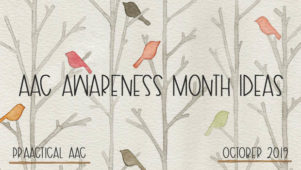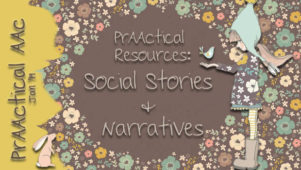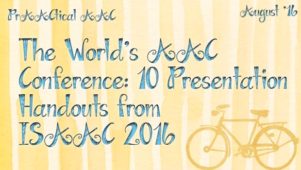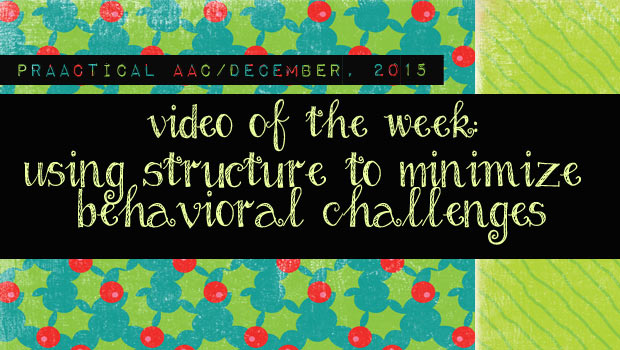18 Search Results for watson
June 4, 2014
by Robin Parker -

The Watson Institute provides a great suggestion for helping to ease transition to Middle School. Additionally, Pen Pals are an awesome idea for improving prAACtical communication. http://youtu.be/EvG5YH0S9rk
July 10, 2023
by Carole Zangari -

Professionals, family members, and AAC users are often frustrated when relevant research is published behind a paywall. Today, we’re pleased to share a number of open-access articles that might be of interest. The effect of aided language stimulation on the acquisition of receptive vocabulary in children with complex communication needs and severe intellectual disability: a comparison of two dosages Laher, Z., & Dada, S. (2023) The effect of aided language stimulation on the acquisition of receptive vocabulary in children with complex communication needs and severe intellectual disability: a comparison of two dosages, Augmentative and Alternative Communication, 39:2, 96-109, DOI: 10.1080/07434618.2022.2155566 Direct link to article: https://www.tandfonline.com/doi/abs/10.1080/07434618.2022.2155566?journalCode=iaac20 A qualitative study exploring the effect of communicating with partially intelligible speech Clarke, Z.C., Judge, S., Fryer, K., Cunningham, S., Toogood, J., & Hawley, M.S. (2023). A qualitative study exploring the effect of communicating with partially intelligible speech, Augmentative and Alternative Communication, 39:2, 110-122, DOI: 10.1080/07434618.2023.2206910 Direct link to article: https://www.tandfonline.com/doi/full/10.1080/07434618.2023.2206910 ... [Read More...]
May 18, 2020
by Carole Zangari -

The use of pain scales is common in healthcare settings to help identify and monitor levels of discomfort. To better address the needs of individuals with significant communication difficulties, Northgate Hospital in the UK created a more detailed tool that expands this concept. Today, we look at the Disability Distress Assessment Tool (DisDAT) which identifies distress and things that signal that for a specific individual with a communication difficulty. DisDAT helps to identify the ways that a specific individual with complex communication needs shows signs of distress and discomfort. You can explore the DisDAT and learn more about how to use it here. There is also a form for monitoring these signals over time (click here for download). Many thanks to the team at Northgate Hospital for creating these tools and making them freely accessible. :::::::::::::::::::::::::::::::::::::::::::::::::::::::::::::: Regnard, C., Reynolds, J., Watson, B., Matthews, D., Gibson, L, & Clarke, C.... [Read More...]
October 1, 2019
by Carole Zangari -

In our part of the world, October brings pumpkin spice lattes, Halloween costumes, and apple cider. But no matter where you live October is more than pumpkins and Halloween. It’s internationally recognized as AAC Awareness Month and it offers a wonderful opportunity for spreading the word as to how we can support people with complex communication needs. Here are a few ideas to get you started. Make an AAC Awareness Bulletin Board in your school or clinic. These materials can be used to create an AAC Awareness display. Download the files, print on color paper, and you are ready to assemble your display. Punch up the display with an AAC poster, like Lauren Enders’ AAC Boot Camp-Getting AAC Users to Communicate or Kate Ahern’s The Periodic Table of AAC . Other ideas: Print, hang, or give someone an AAC awareness image 10 Commandments of AAC Devices Spice up your AAC instruction with... [Read More...]
January 17, 2019
by Carole Zangari -

Social narratives are a promising intervention for people with autism and others who need assistance in understanding the expectations for various situations. The term Social Story, coined by Dr. Carol Gray, refers to one specific type of social narrative that has particular rules for its structure and development. Social narratives, a broader term, includes other kinds of stories that help AAC learners and others better understand the expectations of various situations. They are often used when building an understanding of various life experiences, such as how to respond in a fire drill or what to expect on a trip to the doctor. Here are some helpful resources with more information on social stories and social narratives. AFIRM Module for Learning About Social Narratives (comprehensive tutorial) Carol Gray: What are Social Stories? Overview of Social Stories About Social Stories Social Stories and Behavioral Issues Making Social Narratives with iMovie Sample Social Narratives and... [Read More...]
February 15, 2017
by Carole Zangari -

Yesterday was Valentine’s Day. Sally SLP planned an adorable craft activity, but her students with autism and AAC needs just didn’t take to it. Tara Teacher brought out some age-respectful stickers to decorate cards, but several of the students stopped after placing just one sticker and got frustrated when encouraged to add more. Olivia OT pushed into the classroom as they were painting hearts to help with fine motor skill development, but some of the kids resisted doing anything more than a few brush strokes. Sound familiar? Art activities offer great potential for communication learning and practice, but they aren’t always preferred activities for some of our AAC students. There can be several good reasons for that, but a common problem is that the activity itself may be too open-ended. Some of our students do best with activities that have a clear beginning and ending. Open-ended activities, like many of... [Read More...]
August 15, 2016
by Carole Zangari -

It was so wonderful to meet and learn from so many colleagues and families at the 2016 ISAAC Biennial Conference last week. What an amazing experience to participate in an AAC event withcolleagues from 40 countries! ISAAC 2016 really was the world’s AAC conference. There was an active Twitter thread with a running account of the activities in sessions, social events, and the exhibit hall (see tweets from #ISAAC2016 here). The opening ceremonies started off strong with Vic Valentic’s performance (using AAC) of “I’ve Got a Lot to Say,” a song written by Vivian Butch. You can learn more about their collaboration and see an earlier performance of that song here. Keynote speaker John Draper, founder of Together We Rock, then gave a funny, engaging talk that addressed the contributions of clinicians, educators, researchers, and technologists alike. I was honored to be invited to present two pre-conference sessions on Day 1... [Read More...]
June 29, 2016
by Carole Zangari -

Over the years, we’ve written quite a bit on the prAACtical powers of visual schedules. Activity schedules, known also as mini schedules or task schedules, are great ways to help AAC learners understand what will be happening in a particular activity. Understanding what events will take place helps us all better prepare ourselves for active and appropriate participation in those events. In today’s post, we feature a number of short videos with information on and examples of this strategy. Thanks to the Watson Institute for creating and sharing these videos. Going to the Doctor’s Office Going to the Library Going to Physical Education (PE) Class Going to a Fast Food Restaurant Getting Ready for Bed
January 14, 2016
by Carole Zangari -

Today, we return to The Watson Institute for information on the implementation of visual supports. Their style of creating brief video explanations focused on specific strategies makes these clips perfect for sharing with colleagues and families. Visual Support Power of Pairing: Reinforcers with Visual Supports Build Your Own Schedule: A Structured Choice Strategy You can browse through previous posts featuring the work from this fine team here.
December 30, 2015
by Carole Zangari -

Good AAC therapy is marked by meaningful goals, well-planned instruction, and engaging activities. But for a session to be successful, interventionists also need to be able to manage any problem behaviors that threaten to derail the instruction. Many of the strategies we use to prevent or minimize these behaviors would also be helpful to parents and caregivers. In this week’s featured video, we turn to The Watson Institute in Pittsburgh. This short video is designed to help parents learn about strategies they can use to reduce problem behaviors at home, and can be a great one to share with some of our AAC families. Direct Link to Video: https://www.youtube.com/watch?v=t13ia4_ZImY









